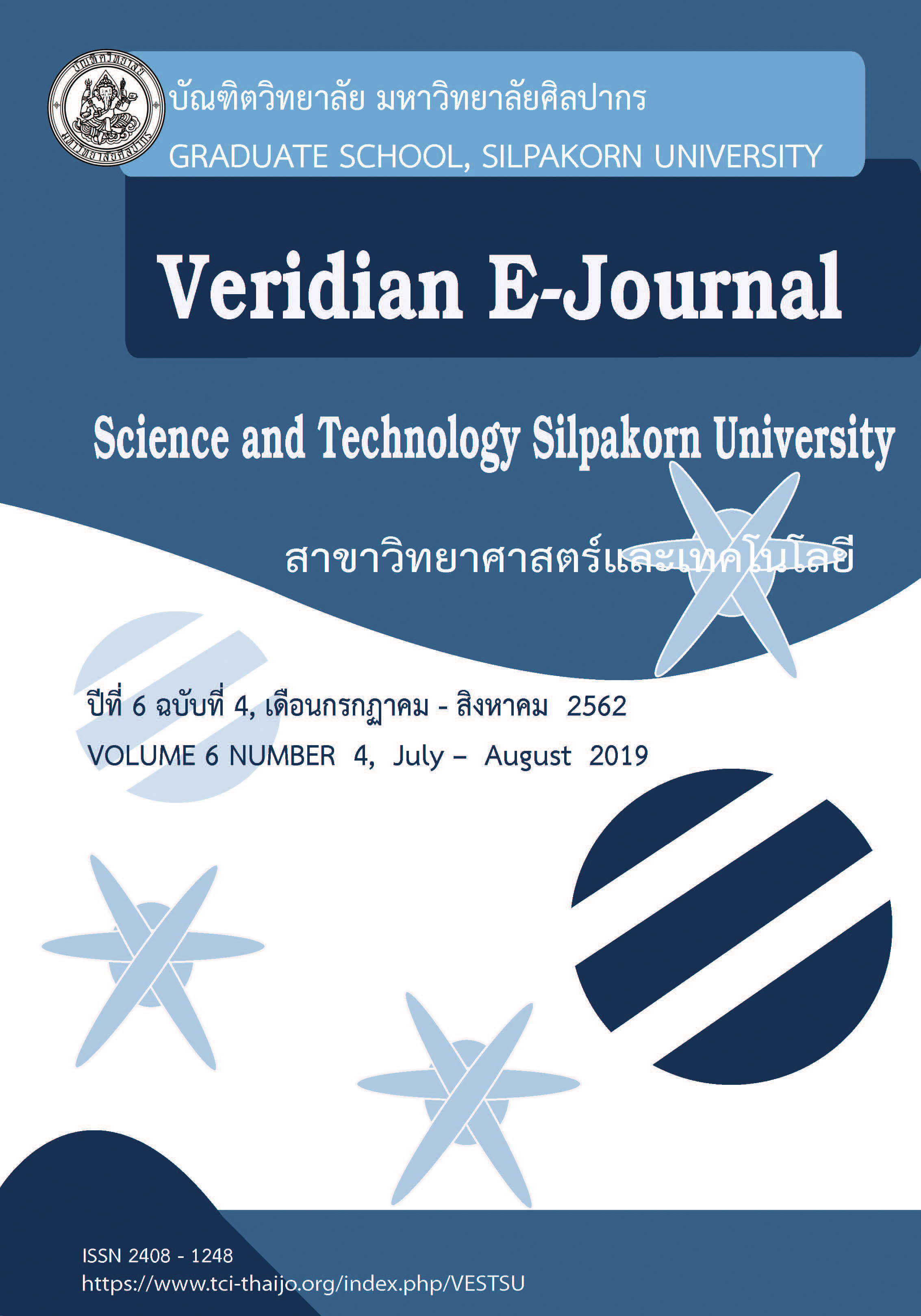อัตราการเกิดปฏิกิริยาทางผิวหนังชนิดรุนแรงจากยาต้านวัณโรคทางเลือกแรก ฐานข้อมูลศูนย์เฝ้าระวังความปลอดภัยด้านผลิตภัณฑ์สุขภาพ สำนักงานคณะกรรมการอาหารและยา กระทรวงสาธารณสุข (Rate of Severe Cutaneous Adverse Reactions Due to First Line Anti-Tuberculosis Drugs: Health Product Vigilance Center Database; The Food and Drug Administration, Ministry of Public Health)
Main Article Content
Abstract
ปฏิกิริยาทางผิวหนังชนิดรุนแรง (Severe cutaneous adverse reactions; SCARs) เป็นปฏิกิริยาที่สามารถส่งผลให้เกิดการบาดเจ็บ การนอนโรงพยาบาล และการเสียชีวิต การเกิด SCARs ในผู้ป่วยวัณโรคมีผลให้ผู้ป่วยต้องหยุดยา และส่งผลสืบเนื่องทำให้การรักษาล้มเหลว มีการแพร่กระจายเชื้อไปสู่ผู้อื่น และเพิ่มโอกาสการเกิดเชื้อดื้อยาได้ งานวิจัยนี้มีวัตถุประสงค์เพื่อศึกษาอัตราการเกิด SCARsจากยาต้านวัณโรคทางเลือกแรกในประเทศไทยวิธีการศึกษาเป็นการทบทวนย้อนหลังข้อมูลปฏิกิริยาข้างเคียงจากยาต้านวัณโรคที่เกิดเหตุการณ์ตั้งแต่ 1 มกราคม 2555 ถึง 31 ธันวาคม 2559 ซึ่งข้อมูลดังกล่าวได้รับจากศูนย์เฝ้าระวังความปลอดภัยด้านผลิตภัณฑ์สุขภาพ สำนักงานคณะกรรมการอาหารและยา กระทรวงสาธารณสุข กลุ่มศึกษาคือรายงานอาการ ไม่พึงประสงค์ของผู้ที่ใช้ยาต้านวัณโรคทางเลือกแรก ได้แก่ Isoniazid (INH), Rifampin (RMP), Ethambutol (EMB), Pyrazinamide (PZA), Streptomycin (Sm) และต้องเป็นรายงานที่ถูกประเมินว่าเกิด SCARs อย่างใดอย่างหนึ่งดังต่อไปนี้ Stevens-Johnson syndrome (SJS), Toxic Epidermal Necrolysis (TEN), Drug Reactions with Eosinophilia and Systemic Symptoms (DRESS) และ Acute Generalized Exanthematous Pustulosis (AGEP) ผลการศึกษาพบรายงานผู้ป่วยเกิด SCARs จากยาต้านวัณโรคทางเลือกแรก 229 คน คำนวณอัตราการเกิด SCARs ได้ 5-6 คนต่อผู้ป่วย 10,000 คนต่อปี SJS เป็น SCARs ที่พบสูงสุด ประมาณการอัตราการเกิดอยู่ระหว่าง 6-8 คนคนต่อผู้ป่วย 10,000 คนต่อปี ขณะที่ TEN, DRESS และ AGEP สามารถประมาณการอัตราการเกิดได้ 1-3, 1-3, และ 0-2 คนต่อผู้ป่วย 10,000 คน ต่อปีตามลำดับ ผู้ป่วยส่วนใหญ่เป็นผู้ป่วยใน โดยพบว่าประเภทของผู้ป่วย (ผู้ป่วยในหรือนอก) มีความสัมพันธ์กับผลลัพธ์ ภายหลังเกิด SCARs (p = 0.017) RMP และ INH เป็นยาสาเหตุหลักของการเกิด SCARs ในผู้ป่วยโดยพบ ร้อยละ 23.30 และ 21.36 ตามลำดับ ขณะที่ EMB, S, PZA พบร้อยละของการเกิด SCARs ร้อยละ19.42, 19.42, และ 16.50 ตามลำดับ ระยะเวลาตั้งแต่ได้รับยาจนเกิด SJS , TEN, DRESS, และ AGEP มีมัธยฐานที่ 15, 36,31และ 22 วันตามลำดับ พิจารณายาต้านวัณโรคทางเลือกแรกแต่ละตัวที่เป็นสาเหตุการเกิด SJS พบว่า มัธยฐานระยะเวลาตั้งแต่ได้รับ INH, RMP, EMB, PZA,และ Sm จนเกิด SJS เท่ากับ 12, 6, 19, 11 และ 14 วันตามลำดับ โดยระยะเวลาตั้งแต่ได้รับ RMP จนเกิด SJS สั้นกว่ายาต้านวัณโรคตัวอื่นอย่างมีนัยสำคัญ (p=0.014)
Severe Cutaneous Adverse Reactions (SCARs) are a group of life threatening adverse drug reactions which lead to morbidity, mortality and hospitalization. Occurrence of SCARs in tuberculosis patient results in treatment interruption, subsequently, treatment failure, transmission to others, and developing of drug resistance.The objective of this study is to examine rate of SCARs due to first line anti-tuberculosis drugs in Thailand. The spontaneous adverse drug reactions reports of patients receiving first line anti-tuberculosis drugs during Jan 1st, 2012-Dec 31st, 2016 were comprehensively reviewed. Data was provided by Health Product Vigilance Center database, Thai Food and Drug Administration, Ministry of Public Health. The study group was the spontaneous adverse drug reactions reports of patients receiving first line anti-tuberculosis drugs [Isoniazid (INH), Rifampin (RMP), Ethambutol (EMB), Pyrazinamide (PZA), Streptomycin(Sm)].SCARs were defined as patients with Stevens-Johnson syndrome (SJS), Toxic Epidermal Necrolysis (TEN), Drug Reaction with Eosinophilia and Systemic Symptoms (DRESS) and Acute Generalized Exanthematous Pustulosis (AGEP).A total of 229 SCARs events was reported. Rate of SCARs were 5-6 person/10,000 person/ year. SJS was the most common SCARs type found with estimated rate of 6-8 person/10,000 person/ year. Whereas estimated rate of TEN, DRESS and AGEP were 1-3, 1-3, and0-2 person/10,000 person/ year, respectively. Majority of patients with SCARs were the inpatient subjects. A significant relationship between patient types (IPD vs. OPD) and SCARs types was found (p = 0.017). The main suspected drug causes of SCARs were RMP (23.30%) and INH (21.36%), following by EMB (19.42%), S (19.42%), PZA (16.50%). The median time to onset were 15, 36, 31, and22 days for SJS, TEN, DRESS and AGEP, respectively. The median onset time of SJS due to INH, RMP, EMB, PZA, and Sm were 12, 6, 19, 11, and14 days, respectively. RMP was associated with shorter time to SJS onset than other first line anti-tuberculosis drugs (p=0.014).

